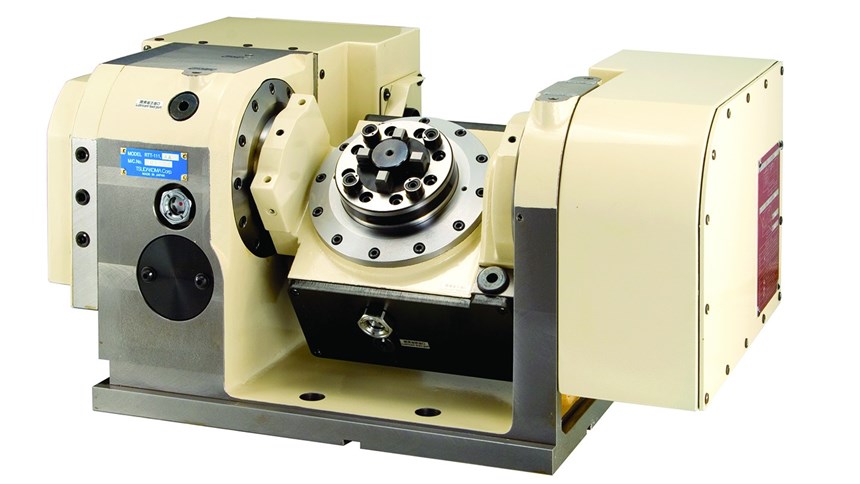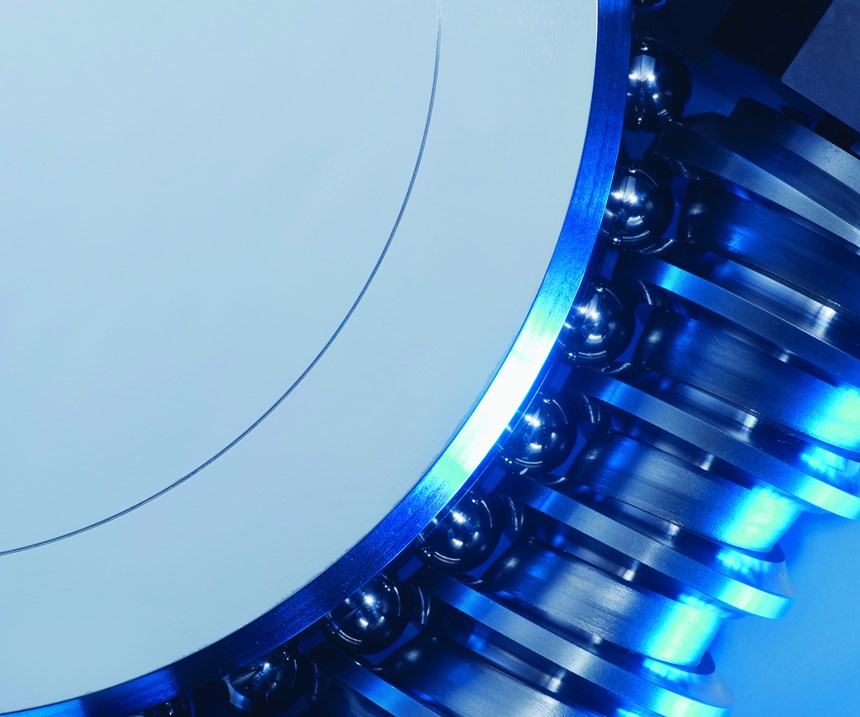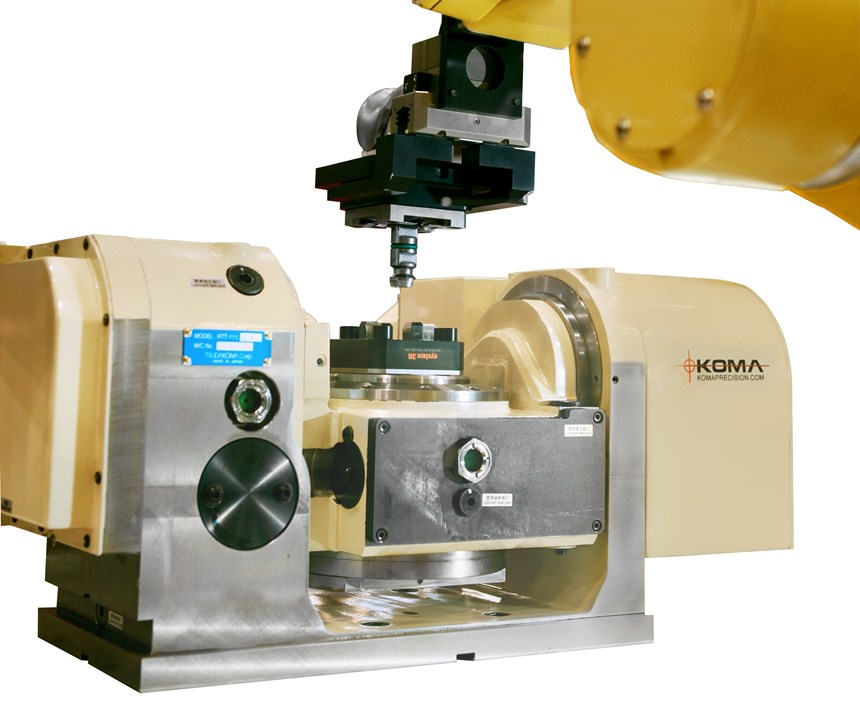Get 5-Axis Machining on a 3-Axis VMC
Machine shops want and need to eliminate steps in the manufacturing process. Adding four- or five-axis capability to an existing three-axis VMC is a practical way to achieve five-sided machining using a single setup.
Every machine tool in a metalworking shop has its function. The right tool for the job. In the case of three-axis vertical machining centers, their fundamental function of linear motion in X, Y and Z axes can be enhanced with the addition of a rotary/tilt table that can add A- and C-axis rotary motion for workpieces that fall outside the range of the Cartesian coordinates.
A machine that was designed for three-axis machining operations can, with the use of a bolt-on accessory, achieve four- or five-axis capability at a significantly lower cost compared with a purpose built five-axis machining center. However, there are some considerations that shops need to understand before jumping from three- to five-axis machining.
Whenever an increase in “time in the cut” can be achieved using a single operation while avoiding additional handling for repositioning, productivity and accuracy go up. The advantage of processing parts more completely with a single setup is an advantage that machining beyond traditional three-axes can enable.
On workpieces that have machined features that are not diametrically opposed, for example, 90 degrees or 180 degrees, indexing or rotation of the part blank in a fourth axis is almost essential to successfully access those features. Adding fifth-axis capability expands complex part feature accessibility with the use of continuous motion or contouring capability.
Having it All
To learn more about considerations that a shop with a three-axis mill needs to consider when adding a rotary/tilt table to its VMC, we talked to David Meo, national sales manager for Koma Precision. Although his company manufactures rotary and tilt tables with up to 1-meter capacity, most of the smaller work uses rotary workholding platters around 4 to 8 inches in diameter.
These compact units are found in shops machining a variety of complex parts used in medical, automotive and aerospace as well as numerous other industries. In the case of shops that are new to machining beyond three axes, these compact units can be mounted to a side of the VMC table, which frees up the rest of the table for other work.
Think of it as having the ability to do three-axis or five-axis machining on demand. In some cases, these “bolt-on” units can be transferred to other capable machines in the shop, adding to their versatility.
Using only a portion of the machining center’s table for tilt/rotary work allows the rest of the table to be set up for regular three-axis workpieces. The decision for the shop is to select the workpieces, based on complexity, which can best be processed using three-axis plus machining techniques.
Getting Around
According to Mr. Meo, around 90 percent of Koma’s tilt/rotary installations involve the use of what’s called a “four-plus-one” approach to five-axis machining. “With this most common approach to five-axis machining, these shops are fundamentally trying to access five sides of the part, but don’t necessarily require contouring capability for most of their applications.
“Most shops are trying to get around the part with a single handling. The biggest killer in a machine shop is usually setup time, and using these accessories for positioning can reduce multiple setups. The idea is that with a tilt/rotary table, the shop can access five sides of a part without the need to stop the machine and re-fixture the part. Eliminating multiple handlings provides reduced runtime and better accuracy.”
In operating a four-plus-one system, one axis is always idle, but the axis selected to be idle can be changed at any point in the program. For example, the first machining operation may involve XYZ and A axes while the geometry of a second part may best be machined using XYZ and C axes. In effect, the four-plus-one system uses four programed axes at one time with the ability to actuate the selected fifth axis as needed.
Simultaneous Five-Axis Machining
Even though most of the work that moves across VMCs equipped with rotary/tilt tables requires positioning access for the cutter to machine the part, some applications do require simultaneous five-axis machining capability. For Koma, its line of rotary/tilt tables are capable of simultaneous five-axis motion if an application needs it.
One workpiece that is emblematic of the need for simultaneous five-axis machining is the turbine blade. Its geometry requires the cutter to be engaged with the work for the entire machining cycle in order to machine the blade satisfactorily. Because of its intricate geometry, full contouring is the only way to process the part.
Making it Go
The actuation mechanism for a rotary/tilt table generally uses a servo-drive worm screw and worm wheel setup to accurately move the rotary table and tilt components. According to Mr. Meo, Koma has recently introduced a new drive system for its rotary/tilt tables that company staff feels is an improvement over the traditional worm screw and worm gear mechanism.
“We call it ball drive technology, and it has been successfully integrated into our four- and five-axis tables,” Mr. Meo says. “The new system is able to provide high-speed movement (100 ipm) with no mechanical backlash. The design of this new bi-directional actuation system eliminates wear compared with a conventional drive system, which maintains the accuracy of the unit over a significantly longer period.”
Movement is important, and these tables have software routines that control the acceleration and deceleration of the unit from one position to the next as part of the program. Also critical is the unit’s braking capability. Cutting forces put a high demand on the static torque capability of a rotary/tilt unit. The Koma unit uses a dual tapered mechanical braking system that is pneumatically actuated. This mechanical system works in conjunction with the self-braking characters of the ball drive technology.
In Control
The machine tool’s CNC is often the limiting factor for shop’s planning on adding rotary/tilt table capability if the goal is simultaneous five-axis machining. While most controls can handle simultaneous four-axis machining, five-axis machining is generally not standard on a VMC’s CNC.
Mr. Meo recommends that if a shop anticipates moving from three-, four- or five-axis capability, it should check before making the original machine purchase. The difference between full five-axis simultaneous capability and the more common four-axis capability is a matter of cost, which becomes fairly insignificant when compared with added ability to machine complex workpieces later when a rotary/tilt table is added.
Even though most of the work a shop needs can be done with simultaneous four-axis motion, having the ability to go the one step forward can mean the difference between getting a job and a no-quote. However, it’s really a CNC capability issue more so than a hardware issue.
“For instance, a FANUC 0i MF CNC, and most controls commonly found on VMCs, are capable of only providing four-axis simultaneous motion,” Mr. Meo says. “For simultaneous five-axis machining capability, the shop would need to order its machine with a FANUC 31ia 5 or its equivalent. Neither of these capabilities are obvious for the three-axis work the machine is designed to perform, but for the shop looking to add rotary/tilt machining to the machine, it can be a big deal.
“That said, most of the controls that are standard on VMCs today can handle four-plus-one machining demands,” Mr. Meo says. “It’s when the shop is looking for bolt-on simultaneous five-axis machining that it needs to go off the standard control menu. CNC OEMs vary, so it’s prudent to have the axis capability discussion at the beginning of the VMC buying cycle.”
It’s when the rotary/tilt table is “married” to the CNC that the control’s additional motion control capability comes into play. For example, the FANUC package on most VMCs comes standard through the interface with X, Y, and Z interface. When Koma adds its turnkey rotary/tilt table system, part of the package is a control interface for the fourth and fifth axis.
For the installation, power and communication, cabling is linked to between the table and CNC. With the connections made, the rotary/tilt table parameters are set, becoming part or the machine’s executive program—effectively creating a post for the additional axes.
Using an encoder system, feedback from the servo-driven motors creates a closed-loop system between the CNC and auxiliary unit. The machine and control does not know there is a difference between three-, four- or five-axis motion capability. Moreover, with the processing speed of today’s CNC technology, there is no effective lag in code processing speed with the additional lines of programming code needed for four- or five-axis positioning instructions.
Quick Change-Over
Many of Koma’s customers, especially those involved in medical and electronic component machining, ask for quick-change capabilities on their rotary/tilt table installations. After the machine has completed its five-sided machining program, the idea is to remove the finished part and replace it with a new blank as quickly as possible.
To accommodate this need for rapid part changing, Mr. Meo says a System 3R or Erowa type of zero-point clamping system can be mounted on the rotary/tilt table faceplate. “Using these clamping systems allows the finished part to be quickly and accurately exchanged with a new part blank using the operator or a robot to accomplish the change-over.”
To accommodate the demand for this quick-change clamping technique, Koma uses a form of universal receiver that is built into the faceplate. “The idea is to be able to accommodate virtually any brand of quick-change receiver available on the market,” Mr. Meo says.
Integration Capability
As machining centers continue to proliferate in shops where the core competency is built around machining parts of rotation, merging the machining center capability into the production mix is relatively new to many shops. Most shops have made the transition with the addition of a milling department to augment its primary turning functions initially as a secondary operation.
With the need to be able to do more work for a given set of customers, some shops have refocused their milling departments from internal service areas to create capabilities that can generate external revenue streams. The trend seems to be to start simple and expand as the skill sets are acquired, which makes planning for additional capability an important aspect of the initial machine purchase.
“We’re seeing this trend of increasing machining sophistication in many of our customer’s shops as the advantages of five-axis machining capability begin to be realized,” Mr. Meo says. “Many shops are coming to us for full system integration built around the flexibility of rotary/tilt tables. We are installing automatic work handling systems using robots, quick-change workholding zero-point clamping systems, and programmable clamping release systems to name a few.
“Over time, the ROI on these upgrades is measureable in months made possible by the five-sided machining capability, reduced material handling requirements and the reduction in no-quotes because of machining limitations. Think of it as a growth model for the business.”
Related Content
Compact VMC Built for Diverse, Simultaneous Applications
The compact model is well suited for shops that want an integrated 5-axis solution for virtually any part that has previously required multiple operations or setups.
Read MoreMazak Custom Machining Solutions Feature Automation, Digitalization
IMTS 2024: Mazak features advanced machining solutions designed to boost productivity in automation, multitasking capabilities and machine tool technology.
Read MoreFive-Axis Machining for Small Prismatic Parts
New to the U.S. market, this compact machine could enable precision turning shops to win complex, more prismatic work in medical and other industries.
Read MoreKaast 5-Axis CNC VMC Offers Rigidity, Cutting Performance
The VMC includes a 30-tool magazine for flexible milling and drilling applications as a standard feature.
Read MoreRead Next
High Accuracy From Direct-Drive Rotary Technology
Consider direct-drive, high-accuracy rotary tables when applying fourth-axis machining capability on the shop floor.
Read MoreA Tooling Workshop Worth a Visit
Marubeni Citizen-Cincom’s tooling and accessory workshop offers a chance to learn more about ancillary devices that can boost machining efficiency and capability.
Read More5 Aspects of PMTS I Appreciate
The three-day edition of the 2025 Precision Machining Technology Show kicks off at the start of April. I’ll be there, and here are some reasons why.
Read More


























